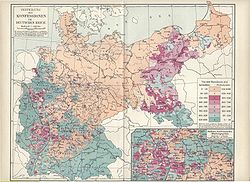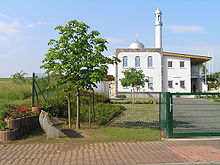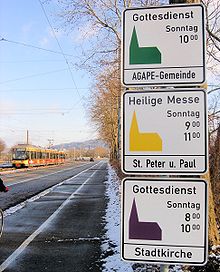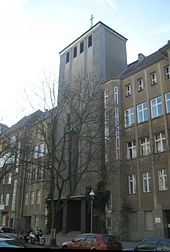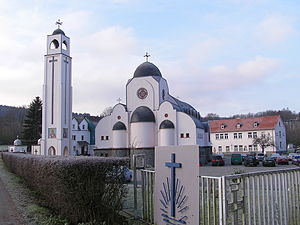- Religion in Germany
-
 2008 map of Christian denominations in the states of Germany [1][2][not in citation given] [3][not in citation given] [4][not in citation given]: Majority of population is
2008 map of Christian denominations in the states of Germany [1][2][not in citation given] [3][not in citation given] [4][not in citation given]: Majority of population is member of the Roman Catholic churchmember of the Evangelical Church in Germany (EKD)either member of the Roman Catholic church or the EKD with EKD the largesteither member of the Roman Catholic church or the EKD with Roman Catholic being the largest denominationmainly not religious, largest Christian minority is EKD
member of the Roman Catholic churchmember of the Evangelical Church in Germany (EKD)either member of the Roman Catholic church or the EKD with EKD the largesteither member of the Roman Catholic church or the EKD with Roman Catholic being the largest denominationmainly not religious, largest Christian minority is EKDChristianity is the largest religion in Germany with 54,765,265 (67.07%) adherents as of the end of 2006,[5] down to 51.5 million adherents (62.8%) as of 2008.[6] The second largest religion is Islam with 3.3 million adherents (4%)[5] followed by Buddhism and Judaism. During the last few decades, the two largest churches in Germany (the Protestant Evangelical Church in Germany (EKD) and the Roman Catholic Church), have lost significant number of adherents, both are down to roughly 30% (by the end of 2008).[7][8] With 30.7 % as per the end of 2008, the Catholic Church is still close to its pre–World War II 1939 percentage of 33%.[9]
The most notable losses occurred in the Protestant churches, in East Germany largely owing to the atheistic policy under the communistic regime. However since the fall of the communistic regime two decades ago, the EKD continued losing members, to just below 30% by the end of 2008.[8][10] Other churches in Germany are all rather small (equal or less than 0.5%).[5] As a result of re-unification (of East and West Germany), the number of Germans without a religion has grown, especially owing to the addition of the eastern states with their large non-religious majority.[citation needed] Due to losses of both the Protestant churches and the Catholic Church in Hamburg, this state has also joined the group of Bundesländer with a non-religious majority.[11][not in citation given]
Contents
Religious communities
Christianity
Roman Catholicism was the sole established religion in the country in the 15th century, but the Reformation changed this drastically. In 1517 Martin Luther challenged the Catholic Church as he saw it as a corruption of Christian faith. Through this, he altered the course of European and world history and established Protestantism.[12]
The Thirty Years' War (1618–1648) was one of the most destructive conflicts in European history. The war was fought primarily in what is now Germany, and at various points involved most of the countries of Europe. The war was fought largely as a religious conflict between Protestants and Catholics in the Holy Roman Empire.[13]
Despite recent losses in adherents, Christianity is still by far the largest religion in Germany,[5] with the Protestant Evangelical Church in Germany (EKD) comprising 29.9% [10] as of 31 December 2008 (down 0.3% compared to the 30.2%[14] in the year before) of the population and Roman Catholicism comprising 30.7% as of Dec. 2008[15] (also down 0.3% compared to the year before).[16] Consequently a majority of the German people belong to a Christian community although many of them take no active part in church life with Sunday church attendance considerably less than 10 percent of which 4.1% are Catholics (in 2008)[17] and 1.2% Protestants (in 2007) belonging to the EKD.[18] 1.7% of the population are Orthodox Christians.[5]
Independent and congregational churches exist in all larger towns and many smaller ones, but most such churches are small. One of these is the confessional Lutheran Church called Independent Evangelical-Lutheran Church in Germany.
Islam
Baitul Huda mosque in Usingen Main article: Islam in Germany
Main article: Islam in GermanyIslam is the largest minority religion in the country. The large majority of Muslims in Germany are of Turkish origin (63.2%), followed by smaller groups from Pakistan, countries of the former Yugoslavia, Arab countries, Iran and Afghanistan. As of 2006, according to the U.S. Department of State, approximately 3.2 million Muslims live in Germany. This figure includes the different denominations of Islam, such as Sunni, Shia, Ahmadiyya and Alevites.
Muslims first came to Germany as part of the diplomatic, military and economic relations between Germany and the Ottoman Empire in the 18th century.[19] In World War I about 15,000 Muslim prisoners of war were interned in Berlin. The first mosque was established in Berlin in 1915 for these prisoners, though it was closed in 1930. After the West German Government invited foreign workers in 1961, the Muslim population continuously rose.
Judaism
Main article: History of the Jews in GermanyToday Germany, especially its capital Berlin, has the fastest growing Jewish community worldwide. About ninety thousand Jews from the former Eastern Bloc, mostly from ex-Soviet Union countries, settled in Germany since the fall of the Berlin wall. This is mainly due to a German government policy which basically grants an immigration ticket to anyone from the CIS and the Baltic states with Jewish heritage, and the fact that today's Germans are seen as significantly more accepting of Jews than many people in the ex-Soviet realm. Some of the about 60,000 long-time resident German Jews have expressed some mixed feelings about this immigration that they perceive as making them a minority not only in their own country but also in their own community. Prior to Nazism, about 600,000 Jews lived in Germany, going back to Roman times or even earlier. Many Jews from Russia and other former communist countries in Germany adhere to Reform Judaism.
Cults, sects, and new religious movements
The German government as well as the churches are actively involved in disseminating information and warnings about sects and cults (in colloquial language the German word Sekte is used in both senses) and new religious movements. In public opinion, minor religious groups are often referred to as Sekten, which can both refer to destructive cults but also to all religious movements which are not Christian or different from the Roman Catholicism and the mainstream Protestantism. However, major world religions like mainstream Orthodox Christianity, Hinduism, Buddhism, Judaism and Islam are not referred to as Sekten.
Information by the EKD and Roman Catholic Church
When classifying religious groups, the Roman Catholic Church and the mainline Protestant Evangelical Church in Germany (EKD) use a three-level hierarchy of "churches", "free churches" and Sekten:
- Kirchen (churches) is the term generally applied to the Roman Catholic Church, the EKD's member churches (Landeskirchen), and the Orthodox Churches. The churches are not only granted the status of a non-profit organisation, but they have additional rights as statutory corporations (German: Körperschaft des öffentlichen Rechts), which means they have the right to employ civil servants (Beamter), do official duties or issue official documents.
- Freikirchen (free churches) is the term generally applied to Protestant organisations outside of the EKD, e.g. Baptists, Methodists, independent Lutherans, Pentecostals, Seventh-day Adventists. However, the Old Catholics can be referred to as a free church as well[20] The free churches are not only granted the tax-free status of a non-profit organisation, but many of them have additional rights as statutory corporations.
- Sekten is the term for religious groups which do not see themselves as part of a major religion (but maybe as the only real believers of a major religion).[21] Examples of groups called Sekten are Ananda Marga and Hare Krishna.[22] Although these religious groups have full religious freedom and protection against discrimination of their members, their organisations in most cases are not granted the tax-free status of a non-profit organisation.
Every Protestant Landeskirche (church whose canonical jurisdiction extends over one or several states, or Länder) and Catholic episcopacy has a Sektenbeauftragter (Sekten delegate) from whom information about religious movements may be obtained.
Information by the government
The German government also provides information about cults, sects, and new religious movements. In 1997, the parliament set up a commission for Sogenannte Sekten und Psychogruppen (literally "so-called sects and psychic groups") which delivered an extensive report on the situation in Germany regarding NRMs in 1998. [23] In 2002, the Federal Constitutional Court upheld the governmental right to provide critical information on religious organizations being referred to as Sekte, but stated that "defamatory, discriminating, or falsifying accounts" were illegal.[24]
Secularism
Before World War II, about two-thirds of the German population was Protestant and one-third was Roman Catholic. In the north and northeast of Germany especially, Protestants dominated.[25] In the former West Germany between 1945 and 1990, which contained nearly all of Germany's historically Catholic areas, Catholics have had a small majority since the 1980s. Protestant areas were much more affected by secularism than predominantly Catholic areas. The predominantly secularised states, such as Hamburg or the East German states, used to be Lutheran or United Protestant strongholds.
There is a non-religious majority in Hamburg, Berlin, Brandenburg, Saxony, Saxony-Anhalt, Thuringia and Mecklenburg-Vorpommern. In the eastern state of Saxony-Anhalt only 19.7 percent belong to the two big denominations of the country.[26] This is the state where Martin Luther was born.
In eastern Germany both religious observance and affiliation are much lower than in the rest of the country after forty years of Communist rule. The government of the German Democratic Republic encouraged an atheist worldview through institutions such as Jugendweihen (youth consecrations), secular coming-of-age ceremonies akin to Christian confirmation which all young people were strongly encouraged to attend (and disadvantaged socially if they did not). The average church attendance is now one of the lowest in the world, with only 5% attending at least once per week, compared to 14% in the rest of the country according to a recent study.[citation needed] The number of christenings, religious weddings and funerals is also lower than in the West.
According to a survey among German youths (aged between 12 and 24) in the year 2006, 30 % of German youths believe in a personal god, 19 % believe in some kind of supernatural power, 23 % share agnostic views and 28 % are atheists.[27]
Religious freedom in Germany
Main article: Freedom of religion in GermanyThe German constitution guarantees freedom of faith and religion. It also states that no one may be discriminated against due to their faith or religious opinions. A state church does not exist in Germany.[28] Religious communities that are of considerable size and stability and are loyal to the constitution can be recognised as "Körperschaften öffentlichen Rechtes" (statutory corporation). This gives them certain privileges, for example being able to give religious instruction in state schools (as enshrined in the German constitution, though some states are exempt from this) and having membership fees collected (for a fee) by the German revenue department as Church tax. It is a surcharge amounting to between 8 or 9% of the income tax. The status mainly applies to the Roman Catholic Church, the mainline Protestant EKD, and Jewish communities. There have been numerous discussions of allowing other religious groups like Jehovah's Witnesses and Muslims into this system as well. The Muslim efforts were hampered by the Muslims' own disorganised state in Germany, with many small rivalling organisations and no central leadership, which does not fit well into a legal frame that was originally created with well-organized, large Christian churches in mind.
List of religious groups and figures
The following is based on estimates conducted in 2006 by the Religionswissenschaftlicher Medien- und Informationsdienst e. V. (REMID) and other sources.
Christianity
- Christians 53.5 million (approximately 65%)[29]
Protestantism
- Evangelical Church in Germany 25.101 million (30.5%) as of 31 December 2006[30]
- New Apostolic Church 400,000[29]
- Aussiedler-Baptisten 300,000-380,000[29]
- Free Evangelical / Charismatic 232,000[31]
- Baptists (mostly Bund Evangelisch-Freikirchlicher Gemeinden in Deutschland KdöR) 86,500[29]
- Methodists 65,638[31]
- Christliche Versammlungen / Freier Brüderkreis / Plymouth Brethren 45,000[8]
- Bund Freikirchlicher Pfingstgemeinden (Pentecostal) 40,000
- Evangelical Methodist Church (Evangelisch-methodistische Kirche), part of the worldwide United Methodist Church 38,000
- Independent Evangelical-Lutheran Church 36,000[32]
- Mennonites 39,414[8]
- Seventh-day Adventist Church 36,000
- Apostelamt Jesu Christi 20,000[10]
- Bund Evangelisch-reformierter Kirchen Deutschlands (Reformed) 13,000
- Christengemeinden Elim (Pentecostal) 10,000
- Danish Church in Southern Schleswig 6,500
- Apostolische Gemeinschaft 6,000
- Gemeinde der Christen - Ecclesia 4,000[32]
- Johannische Church (Johannische Kirche) 3,500
- Church of the Nazarene 1,984[31]
- Gemeinde Christi (Churches of Christ) 1,400
Total: 26,449,926 (32.31%)[5]
Catholicism
- Roman Rite Catholics 25,176,000 (30.7%)[33]
- Maronite Rite Catholics 6,000[5]
Total: 25,442,000
Orthodoxy
- Orthodox Church of Constantinople 450,000[29]
- Romanian Orthodox Church 300,000[29]
- Serbian Orthodox Church 250,000[5][29]
- Russian Orthodox Church 150,000[5]
- Bulgarian Orthodox Church 66,000[5]
- Syriac Orthodox Church 55,000[5]
- Armenian Apostolic Church 35,000[31]
- Ethiopian Orthodox Tewahedo Church 13,000[31]
- Greek Orthodox Church 380,000 [34]
- Assyrian Church 10,000[31]
- Ukrainian Autocephalous Orthodox Church 3,600[32]
- Coptic Orthodox Church 3,000[31]
- Ukrainian Orthodox Church - Kyiv Patriarchate 1,000
Total: 1.8 million (2.25%)
Others
- Old Catholics 25,000
- The Church of Jesus Christ of Latter-day Saints 37,159[35]
- Jehovah's Witnesses 166,000[29]
Total: 228,159
Islam
 A Mosque in Bremen.
A Mosque in Bremen.
- Sunni 2.5 M[29]
- Alevite 1,0 M [10][29]
- Shi'a 225,000[29]
- Ahmadiyya 50,000[36]
- Ismaili 12,000
- Sufi 10,000
Total: 3.6 million (4%), of which 1 million (1.1%) has German citizenship.
Judaism
- Union of Progressive Jews in Germany 3,000 members
- Central Council of Jews in Germany Most Jewish communities
Total: 200,000 (0.25%)[29]
Others
- Buddhists 245,000 (0.30%) (see Buddhism in Germany)
- Hindu 97,500[29] (see Hinduism in Germany)
- Sikh 50,000 (see Sikhism in Germany)
- Bahá'í Faith 5000-6000,[37]
with one of only seven Houses of Worship in the world, see Bahá'í Faith in Germany
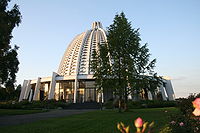 Bahá'í House of Worship, Langenhain, Germany
Bahá'í House of Worship, Langenhain, Germany
No religion
Polls
Existence of a supernatural entity
According to the most recent Eurobarometer Poll 2005,[38]
- 47% of German citizens responded that "they believe there is a God".
- 25% answered that "they believe there is some sort of spirit or life force".
- 25% answered that "they do not believe there is any sort of spirit, God, or life force".
- 3% answered "don't know".
See also
- Buddhism in Germany
- Evangelical Church in Germany
- History of Germany
- History of the Jews in Germany
- Islam in Germany
- Lutheranism
- Martin Luther
- Max Weber
- Protestant Reformation
- Religion by country
- Roman Catholicism in Germany
- Status of religious freedom in Germany
- United and uniting churches
- List of churches in Hamburg
References
- ^ Bevölkerung und Kirchenzugehörigkeit nach Bundesländern Table 1.1 shows 63.4 % of the German population to be Christians of which 2.2% outside the Evangelische Landeskirchen (EKD) and the Roman Catholic Church. Table 1.3 shows overview by German state of membership of the Evangelische Landeskirchen (EKD)and the Roman Catholic Church
- ^ FOWID shows that of the German population 34%is not-religious
- ^ 80% of population in Sachsen-Anhalt is without religion
- ^ religion by Bundesland showing non religious being the majority in Eastern Germany
- ^ a b c d e f g h i j k Religionen in Deutschland - Mitglieder und Anhänger .::. REMID
- ^ (German) "EKD-Statistik: Christen in Deutschland 2007". Evangelische Kirche in Deutschland. http://www.ekd.de/statistik/mitglieder.html. Retrieved 2010-02-13.
- ^ Bevölkerung und Katholiken, 1965–2008. The percentage of Catholics in West Germany alone, starting in 1965 (43.8%) until 2008 (30.7%), under a united Germany, including the eastern states, reflects this difference.
- ^ a b c d FOWID religious adherence of the German population 1950–2008 (including the divided, post-war Germany, then reunited Germany of 1989), document in German issued March 2009
- ^ Hermann Krose, editor, Kirchliches Handbuch fur das Katholische Deutschland (Freiburg: Herder, 1908-1940)
- ^ a b c d Table 1.3 EKD and DBK members by state in 2008 (1.3 Bevölkerung und Kirchenzugehörigkeit nach Bundesländern), document in German retrieved 13 February 2010
- ^ EKD Kirchenmitgliederzahlen (church members as of) 31.12.2007 document in German issued in November 2008 - shows also the number of Roman Catholics and Protestants by Bundesland
- ^ Plass, Ewald M., What Luther Says: An Anthology, St. Louis: Concordia Publishing House, 1959, 2:964.
- ^ Schiller, Frederick, History of the Thirty Years' War, p.1, Harper Publishing
- ^ EKD church members as of 31 Dec. 2007
- ^ German Catholic Church 2008 statistics
- ^ German Catholic Church 2007 statistics
- ^ key figures of the German Catholic church for the year 2008 - document in German
- ^ key figures of the EKD for the year 2007, issued in March 2009.
- ^ State Policies Towards Muslim Minorities. Sweden, Great Britain and Germany, "Muslims in German History until 1945", Jochen Blaschke
- ^ Altkatholiken Freikirche
- ^ Definition "Sekte"
- ^ Definition "Sekte"
- ^ Final report of the commission of the Bundestag on the investigation into so-called sects and psycho groups
- ^ Decision of the German Federal Constitutional Court: BVerfG, Urteil v. 26.06.2002, Az. 1 BvR 670/91
- ^ Ericksen & Heschel, Betrayal: German churches and the Holocaust, p.10, Fortress Press.
- ^ http://www.ekd.de/download/kimi_2004.pdf
- ^ Thomas Gensicke: Jugend und Religiosität. In: Deutsche Shell Jugend 2006. Die 15. Shell Jugendstudie. Frankfurt a.M. 2006.
- ^ Basic Law Art. 140
- ^ a b c d e f g h i j k l m n Germany
- ^ EKD: Evangelische Kirche in Deutschland - EKD - Statistik
- ^ a b c d e f g Adherents.com: By Location
- ^ a b c Adherents.com: By Location
- ^ [1]
- ^ "Foreign Population". Federal Statistical Office of Germany. http://www.destatis.de/jetspeed/portal/cms/Sites/destatis/Internet/EN/Content/Statistics/Bevoelkerung/AuslaendischeBevoelkerung/Tabellen/Content50/TOP10Liste,templateId=renderPrint.psml. Retrieved 2009-01-18.
- ^ LDS Newsroom (Germany)
- ^ http://www.integration-in-deutschland.de/nn_285170/SubSites/Integration/EN/02__Zuwanderer/ThemenUndPerspektiven/Islam/Deutschland/deutschland-node.html?__nnn=true
- ^ "Verschiedene Gemeinschaften / neuere religiöse Bewegungen". Religionen in Deutschland: Mitgliederzahlen (Membership of religions in Germany). REMID - the "Religious Studies Media and Information Service" in Germany. 2007-8. http://www.remid.de/remid_info_zahlen.htm. Retrieved 2008-07-17.
- ^ ReportDGResearchSocialValuesEN2.PDF
External links
- Eurel: sociological and legal data on religions in Europe
- Germany - Catholic Encyclopedia
- Germany - Sacred Destinations
- Statistic by REMID about Adherence to Religious Communities in Germany
- Germans Reconsider Religion
- Religion in Germany (Deutschland): Mitgliederzahlen
- History of Pentecostal Churches in Germany
- KOKID - Kommission der Orthodoxen Kirche in Deutschland (Commission of the Orthodox Church in Germany)
Religion in Europe Sovereign
states- Albania
- Andorra
- Armenia
- Austria
- Azerbaijan
- Belarus
- Belgium
- Bosnia and Herzegovina
- Bulgaria
- Croatia
- Cyprus
- Czech Republic
- Denmark
- Estonia
- Finland
- France
- Georgia
- Germany
- Greece
- Hungary
- Iceland
- Ireland
- Italy
- Kazakhstan
- Latvia
- Liechtenstein
- Lithuania
- Luxembourg
- Macedonia
- Malta
- Moldova
- Monaco
- Montenegro
- Netherlands
- Norway
- Poland
- Portugal
- Romania
- Russia
- San Marino
- Serbia
- Slovakia
- Slovenia
- Spain
- Sweden
- Switzerland
- Turkey
- Ukraine
- United Kingdom
- (England
- Northern Ireland
- Scotland
- Wales)
States with limited
recognition- Abkhazia
- Kosovo
- Nagorno-Karabakh
- Northern Cyprus
- South Ossetia
- Transnistria
Dependencies
and other territories- Åland
- Faroe Islands
- Gibraltar
- Guernsey
- Jan Mayen
- Jersey
- Isle of Man
- Svalbard
Other entities Categories:- Religion in Germany
- German culture
- German society
- Religion in Europe
Wikimedia Foundation. 2010.

